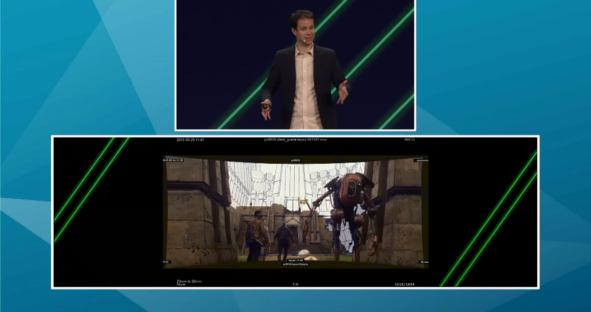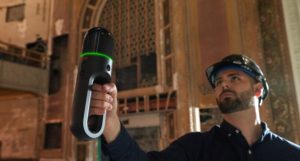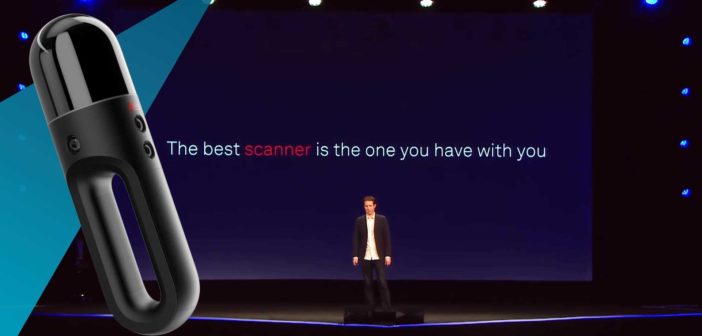As reality capture technology has become lighter, faster, and more user-friendly, users outside of traditional survey-based fields have been adopting and leveraging its benefits. A growing number of industries are adopting reality capture as the go-to tool when physical realities need to be mirrored in a digital world.
This democratisation of the point cloud has especially broadened the possibilities for filmmakers. Whether it is laser scanning for location scouting or embedding 3D digital models and true-scale content in post-editing and production, reality capture has opened a myriad of possibilities to take visual effects (VFX) and computed generated imagery to the next level.
At HxGN LIVE 2019, CTO Burkhard Boeckem presented a keynote speech titled “Embrace Reality: The BLK Story Accelerates,” in which he explained his childhood love for Star Wars and how reality capture technology has been adopted by the film industry, particularly for VFX workflows. He introduced Francois Chardavoine, head of production and technology at Lucasfilm and Industrial Light and Magic, who noted how important laser scanning technology has become for his work:
“There isn’t a single project that comes our way that it doesn’t include some sort of challenge that we’ve never dealt with before. We are always trying to improve ourselves and stay on the cutting edge of technology. Sometimes that means finding solutions that are outside of our industry. Survey and LiDAR equipment are a great example of that. They are obviously very common in construction and other industries, and they have been in use for a long time in visual effects as well.”
Use of LiDAR behind the scenes of Star Wars: The Force Awakens
VFX have notably become more realistic and refined over the years, and that’s no accident. LiDAR technology has enabled content producers to take dramatic leaps forward in their work, and technical precision is key. “Great special effects need to be grounded in reality to ensure that the film content and the digital content that we add seamlessly align and integrate,” Chardavoine explained. “That requires sub-pixel precision and how we solve the camera moves in relationship to the movie set. This is a key area where we use LiDAR data to support everything that we do and make sure everything is aligned.”
Chardavoine then showed an example of a Leica Geosystems total station scanning a Star Wars movie set. To explain the importance of surveying for the film industry, he took us behind the scenes of Star Wars: The Force Awakens. A scene that looks like a typical set location, where Han Solo and company walk from the outside of a castle to the inside of a cantina-style bar, is actually a seamless blend from three different camera takes, multiple environments (both practical and digital from different days and different locations), and laser scanning.
The walls of the outdoor set at the beginning of the scene, which only go about halfway up, had to be extended digitally. Chardavoine showed how the camera pans up, showing a entirely digitally-generated shot—and this is where LiDAR comes in.
Chardavoine highlights how important LiDAR data is, but also explains why it used to be difficult for filmmakers to access. “Unfortunately, historically, LiDAR scanners have been large, expensive, slow. It’s been a cumbersome process. For complex shots, like this one, we’ve been able to plan ahead, but a lot of the time we simply don’t have the data. If you don’t have the data, that can affect your costs, it can affect your quality. And we have to deal with a wide variety of sets. Indoor sets that we are going to extend digitally, outdoor sets that we have to work with as well, and fully-constructed sets where maybe we are only replacing a part of it.”

Yet Chardavoine found the right piece of technology to solve the issues of cost, time, and access to data to create seamlessly realistic VFX. “You want your LiDAR scanning technology to be as portable and as easy-to-operate as possible so that you always have the data available. Take the famous quote: ‘The best camera is the one you have with you.’ For us, the best scanner is the one you have with you. We’ve been using the BLK360 for little over one year and a half. Since then it has become a standard part of arsenal that our crews can just throw in their backpack and go on location whenever needed.”
With its ease-of-use and single-button operation, the BLK360 has already helped many production teams at the upper echelons of the film industry to create 3D models and expand the possibilities in virtual and augmented reality applications, which saves them time and money and grants them immediate access to the data they need.
LiDAR’s next leap forward: the BLK2GO that scans fast and while in motion

The next step in democratising reality capture with a tool that is intuitive and accessible to users in many industries was released at HxGN LIVE 2019: the BLK2GO. The BLK2GO is a wireless handheld imaging laser scanner that seamlessly captures 3D environments while the user is in motion, and continuously creates a digital representation of reality in the form of 3D point clouds and images. The BLK2GO will certainly change workflows within the film industry and the field of VFX, and Chardavoine explains why:
“The new BLK2GO that was announced yesterday is another leap forward that is going to enable us to scan sets, props, vehicles in ways that we’ve never been able to before. It’s really an amazing time to be interacting with some of these devices. Leica Geosystems in particular has been an incredible partner for us in ensuring that we can continue to tackle all of the challenges that are being thrown at us in the future.”
The BLK2GO’s compact and lightweight design (it weighs just 775 grams) allows a much greater degree of mobility, as well as access to spaces and objects that may have been difficult or impossible to scan before. With simple, one-button operation—similar to the BLK360—it is easy to use for professional and casual users alike, and even users with no laser scanning experience. This will open new opportunities for users in several industries, just like the in the film industry.
The BLK2GO combines high-speed dual axis LiDAR (enclosed in a fully protected and encapsulated dome that scans up to 700,000 points per second), a multicamera vision system, an Inertial Measurement Unit (IMU), and SLAM technology to make the BLK2GO self-orienting and scan 3D spaces while in motion. The BLK2GO’s handle contains WLAN connectivity, a rechargeable battery capable of 45 minutes of continuous scanning, data storage for up to six hours of scans, and a USB-C port for fast data transfer in addition to the WLAN data transfer.
With this new array of capabilities, the BLK2GO has a wide range of applications from adaptive reuse projects in the architecture and design industries to location scouting, pre-visualisation, and VFX workflows for media and entertainment.
Visit the BLK2GO website and watch the video to learn the specs and details of this first-of-its-kind handheld imaging laser scanner:

By Renata Barradas, Communications Manager at Hexagon Geosystems














